In a digital age where attention spans are alarmingly decreasing, creating a lasting impact in seconds becomes tedious. Hence, creating logo designs for design branding that captivate the audience instantly is a must for brands.
Think of your logo as a handshake. Much like how people judge a person by their handshake – whether it’s too firm, too limp, or just right – your logo gives the same test. It’s the first point of contact between your brand and potential customers, making that initial impression a critical one.
You might even wonder if putting time and effort into a logo design is worth it or whether a free logo maker will serve the purpose. But at G.O.A.T. Ideas, we believe that your logo is a chance to create a longing first impression on your audience’s mind. So, get it right in the first go! This easy-to-understand blog will help you create a visual identity for your brand. We will also be stating all the do-and-don’ts for designing your dream logo. So, stop pondering further, and let’s figure out logos together.
Introduction to Logo Design for Branding
Imagine a world without logos.
It would be a realm of plain packaging, faceless corporations, and missed opportunities. A world, you’d be bored to live in.
Logos are the visual ambassadors of brands, the graphic storytellers that distill a company’s identity into a single image. They are more than mere symbols; they are the first impression, the lasting memory, and the silent communicator of values and personality.
But since when have we been using logos? Check the next section to dive into the world of history, symbolism, and its significance.
Symbolism and its history

Egyptian hieroglyph on limestone
Symbolism has been prevalent throughout human history through various avenues.
During the Stone Age, when there was no particular language or channel to communicate through, humans interacted with each other by means of symbolism or pictography. It availed communication beyond a language barrier for the Stone Age man.
Old Sumerian, Egyptian, and Chinese civilizations depict paintings & carvings on pottery, big stones, and walls of caves. Despite their limited supply of colors and paints, they created artworks & symbols using natural materials such as charcoal for black, ground calcite for white, and clay ochres and iron oxides for various shades of red and yellow.
As time progressed, the language barrier gradually disappeared. However, this did not diminish the importance of symbolism; instead, it made it even more potent as a means to convey messages and core values in a subtle manner. This subtlety highlights the importance of logos and therefore, the history of symbols and their significance in logo design holds immense importance in the world of Design Branding.
Why does a brand need a logo?
1. It defines your brand
Building an exceptional logo is more than just putting together a few visual elements; it’s about capturing the essence of your brand. To start your Logo Design journey, it’s crucial to first define your brand identity. This involves delving deep into what your brand represents, who your target audience is, and what sets your brand apart from the competition.
At G.O.A.T Ideas, we kickstart this process by immersing ourselves in your brand’s world. Our experienced team conducts thorough consultations to gain a comprehensive understanding of your vision, the specific demographics you aim to reach, and your brand’s unique selling propositions. This in-depth exploration provides the solid foundation upon which we craft a logo that not only looks good but also tells a compelling story about your brand.
2. Brand Recall Value & Association
Achieving sustainable brand recall isn’t always easy, but a good logo can make a difference for your brand. Brand recall value is the measure of how well a logo sticks in the minds of consumers. It’s that instant recognition factor that can make or break a brand’s success. Think about it – when you see a half-bitten apple, you immediately associate it with Apple Inc. Or, a picture of a jumping big cat conjures up images of Puma’s merch. This is what Brand Recall means and you should work towards making a unique logo design.
3. It acts as a promotional tool
Your logo serves as a powerful promotional tool. When collaborating with other organizations or conducting your own events, maintaining a consistent visual identity is crucial because people love consistency. Whether it’s on signage, billboards, flyers, or any other promotional material, a strategically placed logo can elevate the perceived quality of your efforts by providing a cohesive visual element.
In the realm of advertising, it’s essential that everything related to your promotion incorporates your logo. This unifies diverse campaigns under a single brand umbrella, making it instantly clear to viewers that your brand is the driving force behind these events. Your logo becomes the symbol of trust, familiarity, and reliability, reinforcing your brand’s presence and leaving a lasting impression on your audience.
This is exactly what we did for our client – Juju Bar’s launch. We made sure that all the Juju launch hampers contained customized stickers including Juju’s logo too. This ensured brand recall for the patrons. Check out their case study to see how we launched Pune’s first Tequila Bar.
4. Helps differentiate from the competition
A well-crafted logo plays a pivotal role in setting your brand apart from the competition. In a market saturated with choices, a distinctive logo acts as your brand’s unique identifier. It encapsulates your brand’s essence, values, and personality, creating a visual symbol that customers can easily recognize and connect with. Moreover, humans are inherently social creatures, and their decisions are not solely based on rationality. Emotions significantly influence their choices, and this is where a logo wields its power. When customers feel that emotional connection with your brand through your logo, the likelihood of them choosing your products or services over those of your competitors increases significantly.
It’s this unique ability of a logo to engage with customers on both rational and emotional fronts that make it an indispensable tool for brand differentiation and success in today’s competitive landscape.
Types of logos for branding
Logos are a visual representation of a company, conveying its values, personality, and essence to the audience. But not all logos are created equal. There are various types of logos, each with its unique characteristics and applications. Whether you’re a business owner looking to create a logo or a design enthusiast curious about logo design principles, understanding these logotypes can be a valuable asset on your creative journey.
1. Wordmark Logo
Wordmark Logos are one of the most basic types of logos wherein the logo consists solely of the name of the company in a certain font. These logos might look basic, but choosing the correct font/typeface and colors for them is of utmost importance. Consider minute details such as the spacing between the letters, using special characters, and the usage of all caps, small caps, or a combination of both.
Some companies even use the initial letter as their logo, to be used in compact spaces. For eg. Google’s Pixel range of phones uses the monogram ‘G’ logo.
2. Lettermark Logo
If your company or organization has a long name, you should definitely consider a Lettermark Logo. Lettermark logos are made up of the initials of your company’s name or abbreviations. It is usually used if the name of your company is too long so that the abbreviation can increase your brand’s recall value. For instance, we remember the TV Channel ESPN by its initials because it becomes tedious to remember the Entertainment and Sports Programming Network.
3. Symbol Logo
Symbol logos are particularly seen a lot around us. Brands endorse these logos because they are crisp, simple, timeless, and they subtly convey your brand’s message or value. Symbol logos are a pictorial representation of your brand.
Snapchat’s ghost logo is a classic example of a symbol logo and it represents the messages or content that are set to automatically disappear or become inaccessible after a certain period of time once the recipient has viewed them.
Check out the pictorial symbol logo we created for Pune’s Elephant & Co. featured in #30BestBarsIndia!
4. Abstract Logo
Abstract logos are a fascinating category in logo design. Unlike representational logos that directly depict recognizable objects, abstract logos offer an opportunity to create something distinctive and unique. When choosing an abstract logo, it becomes crucial to design your brand’s fundamental values in it. This allows you to experiment with new ideas.
Take the example of Nike’s logo. The iconic Nike Swoosh is a fluid, dynamic shape that conveys a sense of motion, speed, and energy. This abstract representation captures the essence of the brand perfectly, emphasizing athleticism.
You can also check out the abstract logo we designed for Cobbler and Crew!
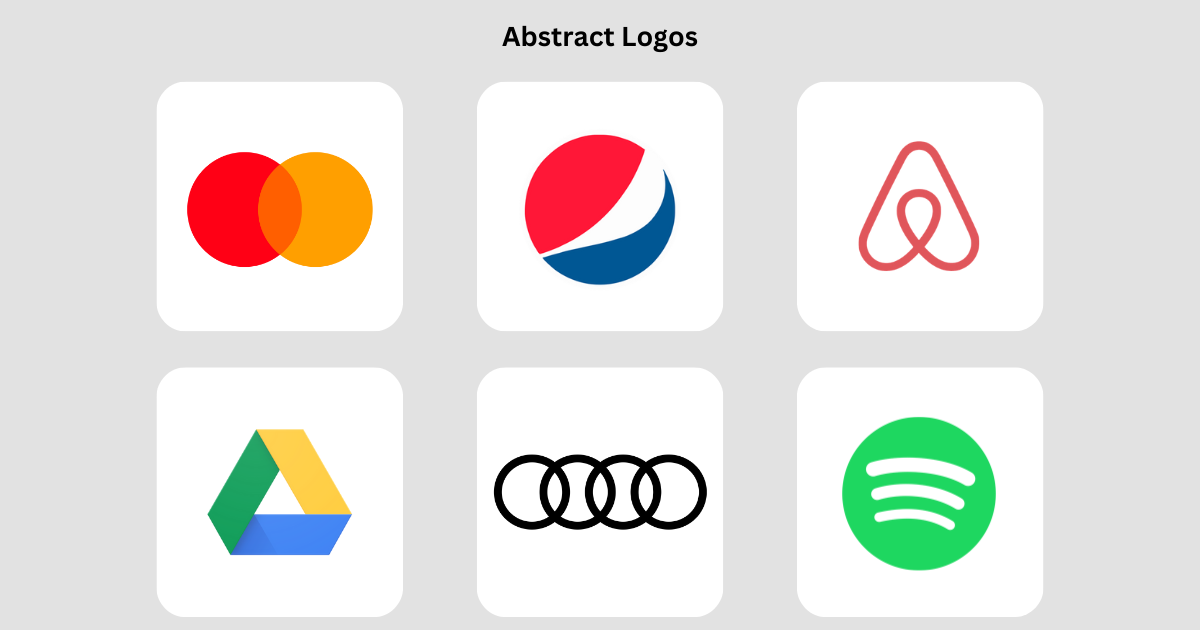
Famous Examples of Abstract Logos – Mastercard, Pepsi, AirBnB, Google Drive, Audi & Spotify
5. Mascot Logo
We all know how mascots are like the beloved figures in school matches. They represent a team, evoking emotions and creating a strong connection, similar to how a mascot logo can represent your brand. Mascot logos feature illustrated characters that represent a brand. They can be real or fictional characters, serving as brand ambassadors. They bring a fun vibe, making them popular for businesses that cater to youngsters.
The most classic example of this type of logo is KFC’s Logo featuring the mascot Colonel Sanders!
6. Emblem Logo
Emblem logos, exemplified by brands like Starbucks, are iconic symbols enclosed within a distinct shape or badge. These logos often combine typography, imagery, and a surrounding border to create a unified emblem.
Emblem logos are known for their intricate designs and rich symbolism, making them highly effective in conveying a brand’s history, values, and tradition. They are especially suitable for businesses with strong narratives and a desire to evoke a sense of heritage and authenticity in their branding. Emblem logos often have a timeless quality, and when well-crafted, they can become instantly recognizable symbols of the brand’s identity.
7. Combination Logo
Combination logos are remarkably versatile, as they can be used together or separately across various contexts, making them ideal for diverse marketing materials and platforms. They strike an exquisite balance between the straightforwardness of a wordmark and the visual allure of a symbol, presenting a comprehensive and memorable representation of the brand. These logos are particularly effective for businesses seeking to convey both a clear brand name and a compelling visual identity.
In the case of Taco Bell’s logo, the brand name is elegantly stylized in text, accompanied by an iconic bell symbol. This dynamic synergy offers a dual approach to brand recognition. Our client Juju Bar’s logo is also a classic example of a Combination Logo!
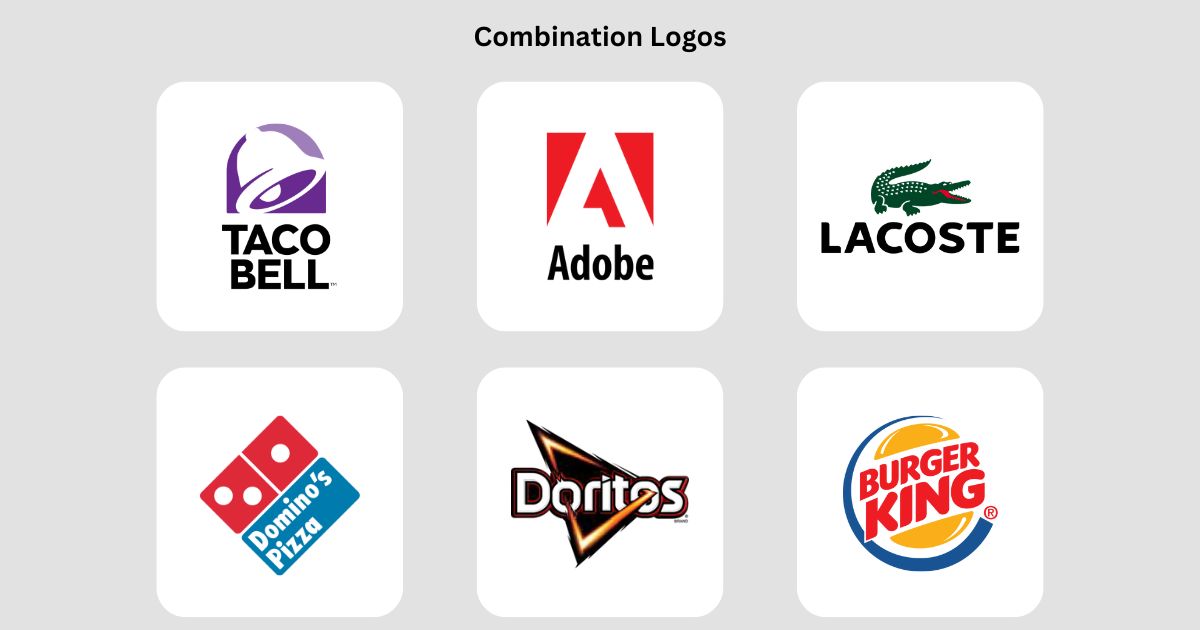
Famous Examples of Combination Logos – Taco Bell, Adobe, Lacoste, Domino’s Pizza, Doritos & Burger King
Things to remember while making a logo
-
Research and referencing
These two activities serve as the foundation for our designers’ creative vision when working with all our clients. Why? Because they offer a deep understanding of the industry landscape and provide invaluable insights into your target audience. Before starting with the logo design process, it’s essential to have a crystal-clear understanding of your brand’s mission, vision, and the role it will play. This groundwork also involves examining industry trends, studying visual language, gathering points of reference for inspiration, and charting a clear course for your creative journey toward forging a distinctive brand identity. For more insight, you can refer to the content provided by famous Design-related content creators. You can also study content from Design-related books like Branding: In Five and a Half Steps by Michael Johnson or Logo Modernism by Jens Müller and R. Roger Remington.
-
Sketching and Conceptualizing
Sketching and conceptualizing are the foundational stages where ideas are born and take their initial form. It’s the time when our designers put pen to paper, allowing their imaginations to flow freely. Sketching provides an organic platform to explore diverse concepts, shapes, and arrangements. It’s a raw, unfiltered phase where every stroke matters, as it contributes to the evolution of the final design. Conceptualizing, on the other hand, involves refining these initial sketches, aligning them with the brand’s identity, and imbuing them with meaning. It’s a delicate dance of creativity and strategy, where the logo starts to take shape as a visual representation of the brand’s essence.
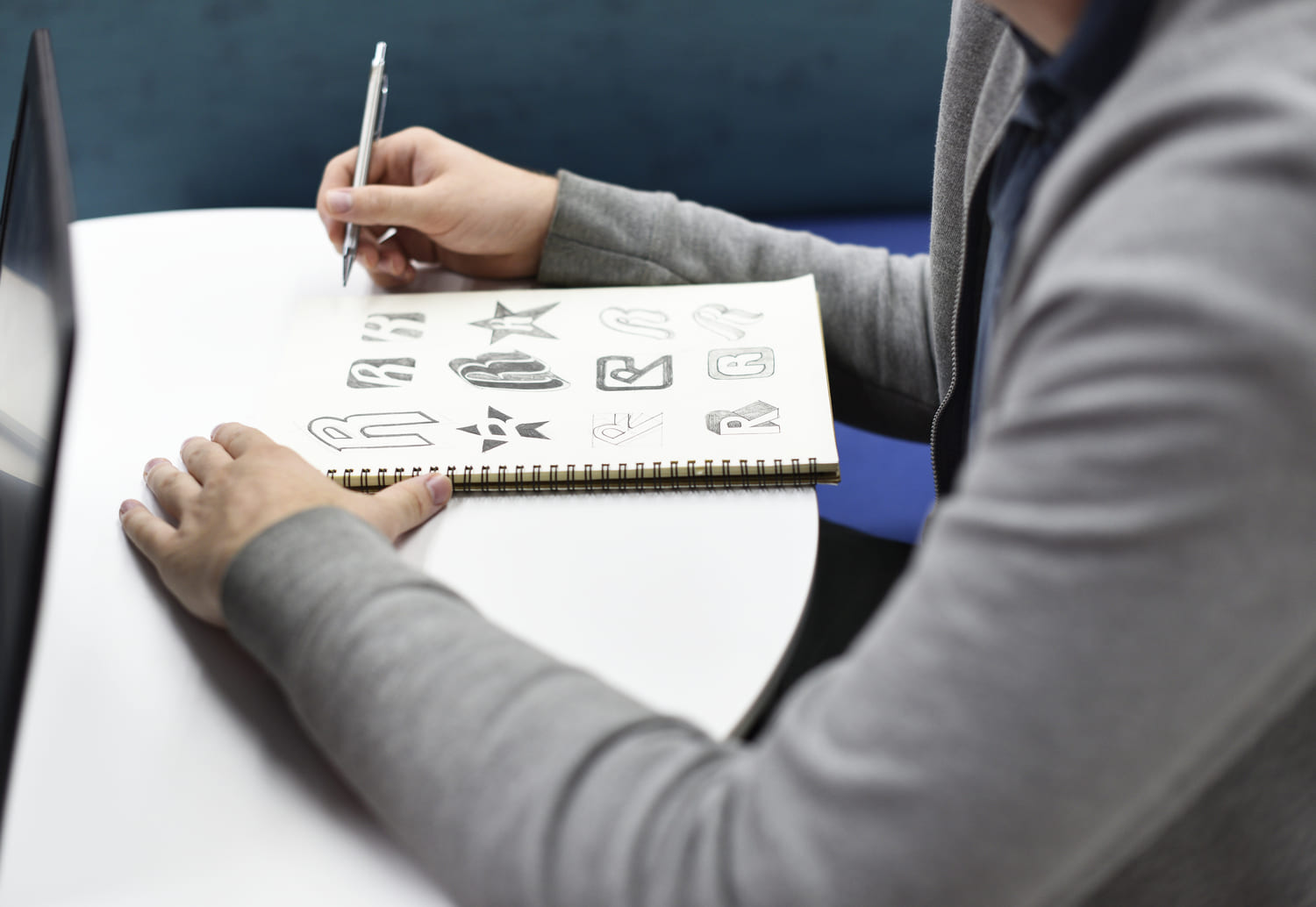
Sketching logo designs is very important to get your design flow going
-
Making drafts and revising
This phase transforms the initial sketches and concepts into tangible drafts, each iteration refining the design further. Our designers craft multiple drafts, experimenting with various color palettes, typography choices, and layout arrangements. These drafts serve as the foundation for constructive feedback and critical evaluation. Revisions are made with precision, each change aimed at enhancing the logo’s impact and resonance. Keep taking your client’s feedback and work on those to get better and better!
-
Choosing a design style
Choosing a design style depends completely on how you want to present the brand to your audience. Is it going to be a loud and fun-loving brand, or is it going to be a more sophisticated and minimalistic one?The three main parts of designing your logo are as follows:
a) Color Palette
Selecting the right colors for your logo and branding is a crucial decision in the design process. Colors carry immense psychological and emotional weight, and they can evoke specific feelings and perceptions in your audience. Consistency in color usage across all branding materials fosters brand recognition and reinforces your brand’s identity in the minds of consumers. Hence, studying the Color Theory and Psychology of Colors for Logo design is very important.

b) Typography
The choice of typography, or fonts for your logo and branding, is a subtle yet powerful aspect of design. Different fonts evoke different emotions and associations. For instance, a sleek, sans-serif font might communicate modernity and minimalism, while a decorative script font could evoke elegance and tradition. Along with this, consistency in typography across your branding materials helps create a cohesive and professional image for your brand.
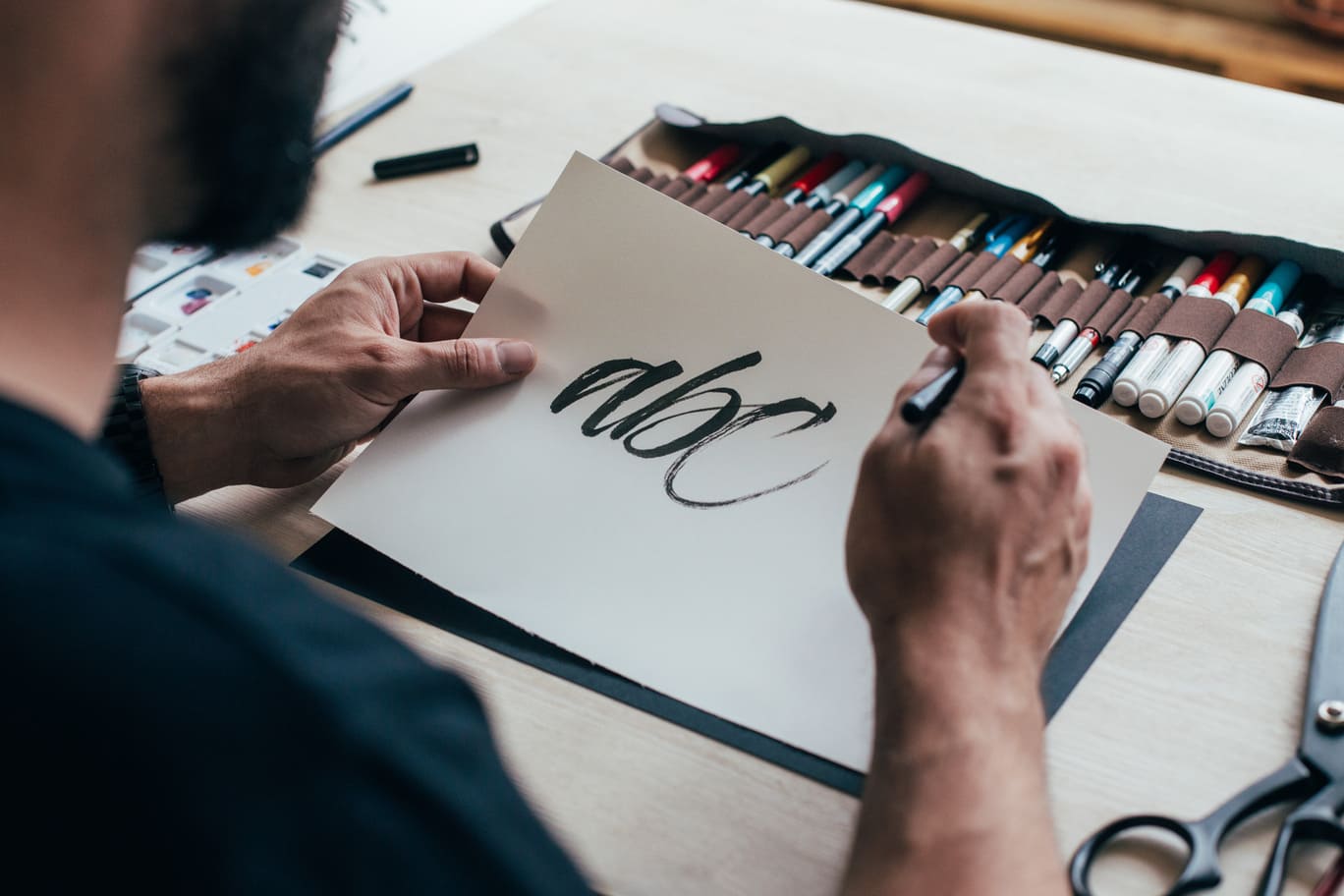
Selecting appropriate fonts for your logo is a crucial step in defining your brand’s aesthetic
c) Iconography
Logos become immensely fun when iconography comes into play. Not only do they convey meaning but also give your creativity some space to evolve. However, understanding the meaning behind the iconography and understanding cross-cultural relevance is very important. For instance, an owl symbolizes wisdom and intelligence. But in some parts of the world, it is believed that owls bring bad luck or even death. So, it’s crucial you understand, where and whom you’re targeting. If your business is targeting an older audience in Africa, utilizing an owl in your logo is a BIG NO.
Have a look at how we used creative iconography in Juju Bar’s logo which is a Mexican-themed Tequila Bar from Pune.
Testing your logo
Now that you’ve conducted extensive research, gone through the conceptualization process, and sketched and integrated all the critical elements for your logo design, it is time to finalize one logo for your brand. Before unveiling it to the public, it’s imperative to conduct a comprehensive logo evaluation of your finalized logo designs. It’s time to put your finalized designs to the test!
1. Taking a survey
This process starts with making a hypothesis. While creating the logo, you must have studied the brand’s identity and tone of voice. That study will help you outline your goal. Define your objective, and once your logo is ready, ask people if the logo can communicate the decided objective.
But to decide on an objective for your hypothesis, you must make a question bank to survey people. Ask everyone the same set of questions and analyze the data that you get to settle on your final logo.
Here is a short questionnaire that you can use while doing your logo survey.
- What do you think about this logo? Does it look modern or does it look traditional?
- Do you like the color combination used?
- What picture comes to your mind when you see this logo?
- Do you like the font of the logo? Does it go with our logo aesthetic?
- Is the logo distinguishable from the other competitors?
- On a scale of 1 to 10, how much did you like the logo?
- What do you dislike about the logo?
- Any suggestions?
Use this questionnaire, come up with more relevant questions, and get your logo fixed!
2. Try out a user-testing platform
Many user testing platforms are readily available on the internet, offering efficient logo testing without any complications. Platforms such as Poll the People or UsabilityHub offer swift analysis and yield valuable results. You can then review the feedback provided by the platform and make an informed decision to select the ultimate logo for your brand!
3. Have internal discussions within your team
Promote open communication and foster internal discussions among your team members and clients. A productive brainstorming session can provide added clarity regarding the logo’s direction and enable more effective strategic planning. This collaborative process often leads to the finalization of your logo design.
Summary
If you’ve made it this far, congratulations! You’re just a step away from getting that perfect logo. Undoubtedly, this journey is a blend of creativity and hard work, filled with research and execution, but the final result is well worth the effort. While online free logo maker can help you create a logo quickly, shortcuts rarely yield long-term results.
Don’t hesitate to seek professional assistance for your brand. Throughout this blog, we’ve explored the many reasons why a logo is essential and its role in shaping a brand. So, why second-guess it? If you find yourself unsure, consider involving the experts.
At G.O.A.T Ideas, we could be your ideal partner for crafting the perfect logo. We design logos that align with market standards and cater to your unique needs. We’ll guide you through the process, ensuring that your logo becomes the standout symbol of your brand.
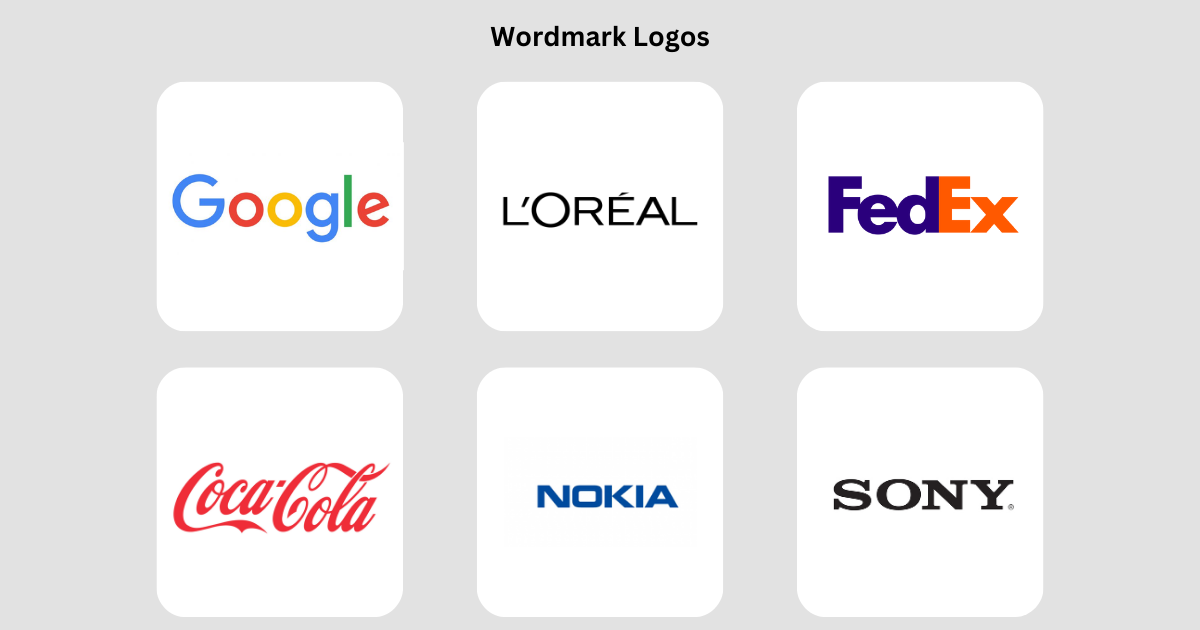


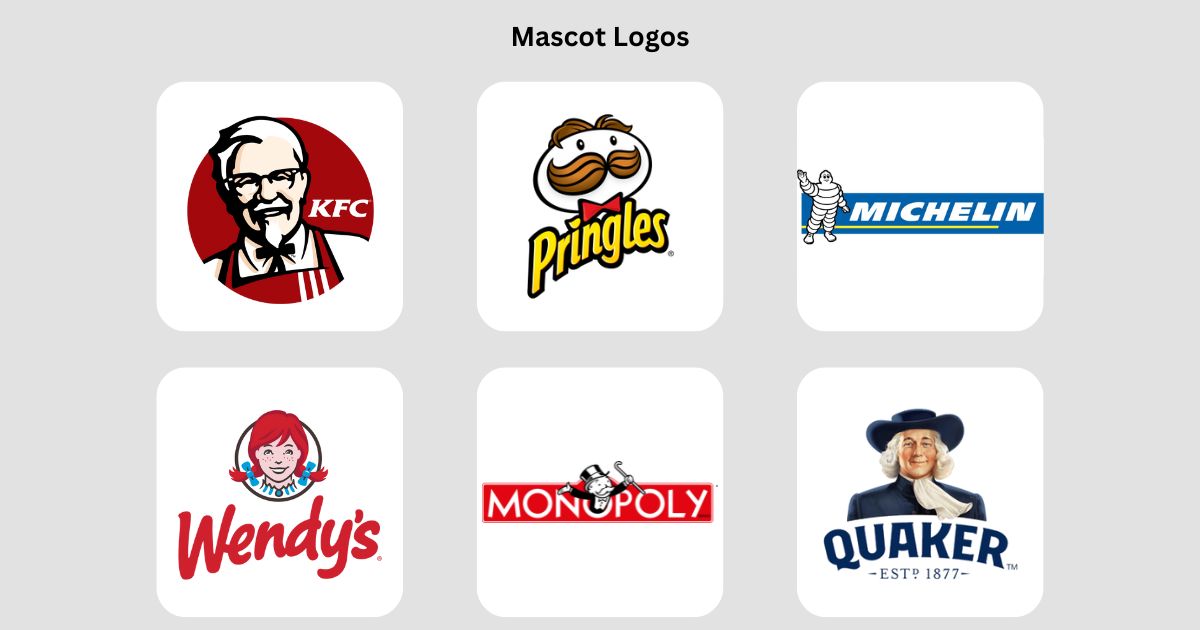
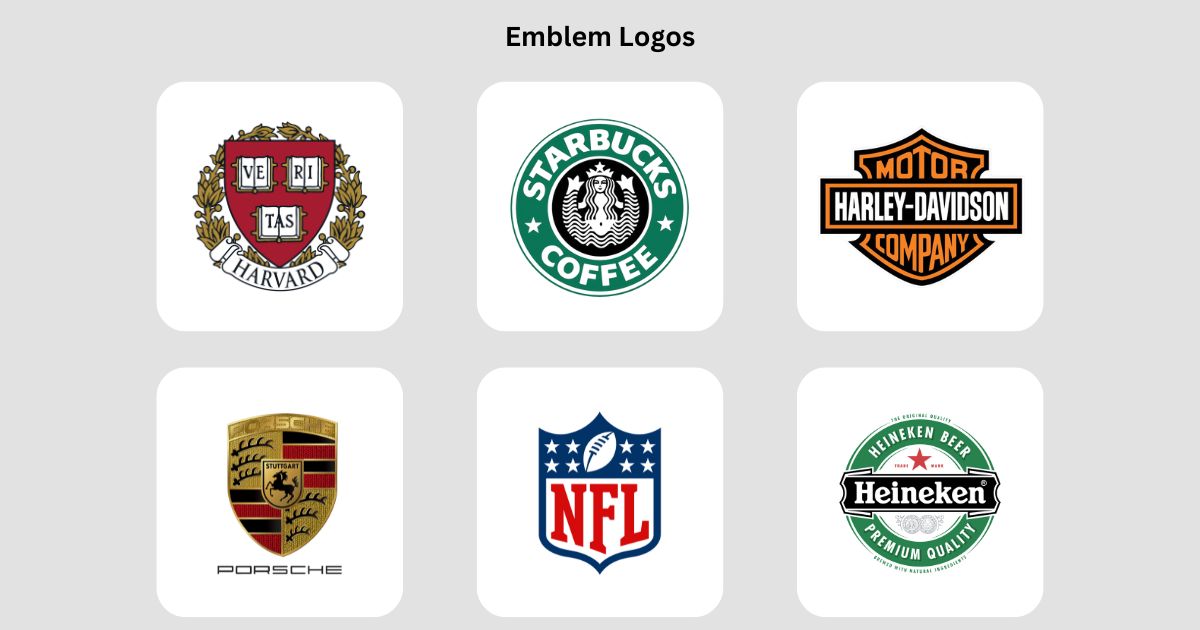
Very Informative